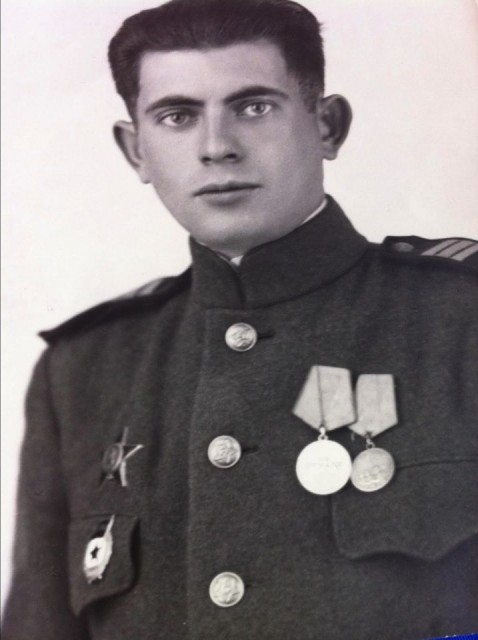Happy Significant Birthday to Alisa on March 5th! Those of you who read Jewish Luck remember Alisa is one of the two women who survived the Soviet era to thrive as a world citizen today. If you check the family tree in Jewish Luck, you'll be able to work out just how old Alisa is.
Alisa wrote to me saying, "I know XX is only a number! But I don't feel like one, I don't look like one, I have cool work, and live the adventurous life which I missed when I was younger."
Alisa is absolutely correct that she appears at least 15 years younger than she is and has the energy of a millennial. Her parents, on the other hand, looked much older than their years in photos. Alisa tells Leslie and me, "they had too hard a life." The suffering and deprivations are written into the lines of their faces and the contours of their body.Our visit with Alisa's mom, Bella, in 2011 included her reminiscences of Naum (Alisa's dad) and his service in the Great Patriotic War. I remember Bella's hands as they lovingly arranged all the medals including "hero of Leningrad" across her kitchen table.
Thoughts of Alisa and her family accompanied me last week when I visited the exhibit at our local Museum of Russian Art—The Leningrad Siege or blokada in Russian. (http://tmora.org/2016/12/26/the-siege-of-leningrad/)
Our docent, Carol, had presented a comprehensive lecture earlier this week outlining the history of the 900-day siege from 1941-43 and focusing on the role of the artists who created posters, photographs, paintings to reflect the suffering and the heroism of Leningraders. Twenty of us toured with Carol who is at once fiercely passionate and dispassionate. She can evoke the abject pain of starving citizens and she can explain the expert brush strokes on a painting, the symbolism on a poster, or the geography of the Nazi entrenchment encircling the city. Most poignant to me were the facsimiles of artifacts—death certificates and ration cards. I found myself searching the photos and wondering whether Alisa's dad or grandparents or Vera's mom and her family were hidden among the haggard faces. As we approached Jill Bough's photographs of older Russians she has interviewed (http://jillboughphoto.com/projects/blokadnitsy-project/), I thought about our interview with Bella. She resembled the women Jill Bough photographed. Like Bella, the women are unlikely looking heroes. Vera's mother, too, could have spoken about her return to Leningrad during the siege and serving as a nurse while she was still a teenager. For all these women, this is a critical component of who they are.
Besides the personal connections to the Leningrad Siege, I was reminded of Alisa's words she wrote to me about the Siege on Aug. 8, 2010.
"I am thinking about books and movies describing Jews who participated in the 2nd World War, Jewish soldiers and fighters against Hitler. Russians never did it, there is no publication, to my knowledge, about Jewish heroes who gave their lives and who struggled for freedom and for [the] Russian people."
Alisa's observation hovered above me as I searched for some remark, some acknowledgment. But, Stalin's ideology didn't allow for Jewish heroism in Leningrad to be recognized just as he didn't acknowledge the slaughter of Jews in western Russia at times aided by Russians who pointed out their Jewish comrades.
Here's a story of a Jewish soldier, loyal to the Red Army, but also loyal and loving to his family. Alisa's stark prose as she recounts her dad Naum's experience could have accompanied the images at The Museum of Russian Art.
"At the beginning of the war, in 1941, after 10-years [of] school, Naum was drafted into the Red Army where he studied at the military school of communication. In 1942 he was sent to the war. He started from the "Pulkovskiji visoti," where his battalion was placed to defend Leningrad – that was a start of the city's blockade."
"My dad's family, Gita, Aron, Frida were starving as all others during that dark time. So my dad, each night when all his others comrades went to sleep, went on foot through the entire city, to share his soldier ration, small portion of bread with his family- that may be was one of the reasons that they did survive."
"Naum was among those who defended Leningrad, struggled with Germans for liberation of Eastern Europe, went through Poland and participated in the last fight taking of Berlin."
"Naum has a lot of War Hero medals. On Victory Day he used to put them all on his jacket. For many years he never spoke about the war, but later he started telling "war stories" to his grandson (my brother's son Misha)."
"Naum told me in Sweden (my parents reunited with me in Sweden in 1995) that at the end of the war he could easily defect in Berlin (where Russian, Americans and English troops stayed); he used to [ex]change cigarettes and vodka for American chocolate and did it in the American zone where he could stay. That thought never came to him."
"In Sweden about a year ago [the] Russian embassy interviewed families and published a book about Russians in Scandinavia. There is a chapter about Naum Belenkij, a soldier, a hero and war veteran. And I am very proud about it!"
Stories of the blokada, the siege, are part of every survivor family's reality. Leslie and I included Vera's accounts of her parents' families Leningrad experiences in chapter 15 of Jewish Luck. It's not just part of Alisa and Vera's heritage, it's also taught them lessons about perseverance and is part of their character.
If you visit this exhibit, read one of the many works of fiction or non-fiction about the siege of Leningrad, or listen to Shostakovich's Seventh Symphony, think of the suffering. The message of the exhibit is that survival itself was heroic. The siege is ever present in today's St. Petersburg. Like the physical damage it inflicted on its survivors, it marked the cityscape and the city's psyche. Of course, there were some Leningraders whose behavior during the blokada was less than heroic, but those memories are not part of the exhibit and official Russian History has pushed those incidents aside.
After seeing an exhibit like this and thinking again about our friends' families, I feel compelled to ask, did this have to happen? What if Stalin had listened to his spies like Richard Sorge who warned him Nazi Germany was preparing an invasion for the summer of 1941? What if Stalin had not ordered the purge of the Red Army beginning in 1937 that led to the deaths of his most skilled marshal, Mikhail Tukhachevskii, along with thousands of others. More than 30,000 Red Army leaders were killed, exiled or removed from the Red Army on the eve of the Great Patriotic War. What if Stalin had not been doubtful of Leningrad's patriotism and loyalty to him before the war and even after the war?
The words of poet Olga Berggolts who survived the blokada are inscribed on the memorial at Piskarevsky Cemetery.
"Here lie the people of Leningrad,
Here are the citizens—men, women, children—
And beside them the soldiers of the Red Army
Who gave their lives
Defending you, Leningrad.
Cradle of the Revolution.
Their noble names we cannot number
So many lie beneath the eternal granite
But of those honored by this stone
Let no one forget,
Let nothing be forgotten."
Let nothing be forgotten—let everything be remembered. And you, reader, can decide the relevancy for today.






